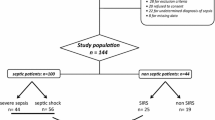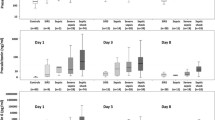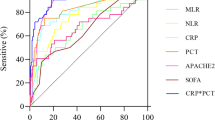Abstract
Background
Sepsis is a serious problem in intensive care units all over the world. Biomarkers could be useful to identify patients at risk. We focused especially on the performance of presepsin (sCD14-ST), compared to C-reactive protein (CRP), procalcitonin (PCT) and CD64, to determine its diagnostic and prognostic indications.
Methods
The study was conducted on 47 hospitalized patients after procedures, who were divided into three groups; systemic inflammatory response (SIRS), sepsis and septic shock. Expression of CD64 on neutrophils presented as CD64 index, sCD14-ST, CRP and PCT were measured in whole blood or plasma samples. All patients had standard samples like urine, respiratory tract samples etc. taken for culturing. Blood cultures were drawn to confirm bloodstream infection.
Results
Forty (85 %) patients had SIRS with bacterial infection and seven (15 %) patients had SIRS with no infection. All infections were confirmed with blood cultures. Biomarkers were evaluated in all patients. In patients with confirmed infection the values were high. The patients with bacterial infection showed statistical significance with CD64 index (p = 0.003), CRP (p = 0.049) and sCD14-ST (p = 0.026), but not with PCT (p = 1.000). The severity of diagnosed SIRS was significant only with PCT (p < 0.001).
Conclusion
CD64 index, CRP and sCD14-ST served as good parameters to determine possible infection in patients that needed intensive care after major procedures. Values of PCT were the only ones to predict SIRS severity and could distinguish between sepsis and severe sepsis or septic shock.


Similar content being viewed by others
References
Prashant A, Vishwanath P, Kulkarni P, Sathya Narayana P, Gowdara V, Nataraj SM, et al. Comparative assessment of cytokines and other inflammatory markers for the early diagnosis of neonatal sepsis—A case control study. PLoS One. 2013;8(7):e68426.doi: 10.1371/journal.pone.0068426.
Wong HR, Salisbury S, Xiao Q, Cvijanovich NZ, Hall M, Allen GL, et al. The pediatric sepsis biomarker risk model. Crit Care. 2012;16(5):R174. doi:10.1186/cc11652.
Levy MM, Artigas A, Phillips GS, Rhodes A, Beale R, Osborn T, et al. Outcomes of the surviving sepsis campaign in intensive care units in the USA and Europe: a prospective cohort study. Lancet Infect Dis. 2012;12(12):919–24. doi:10.1016/S1473-3099(12)70239-6.
Dellinger RP, Levy MM, Rhodes A, Annane D, Gerach H, Opal SM, et al. Surviving sepsis campaign: international guidelines for management of severe sepsis and septic shock: 2012. Intensive Care Med. 2013;39(2):165–228.
Jordana-Lluch E, Carolan HE, Giménez M, Sampath R, Ecker DJ, Quesada MD, et al. Rapid diagnosis of bloodstream infections with PCR followed by mass spectrometry. PLoS One. 2013;23:8(4):e62108. doi: 10.1371.
Reinhart K, Bauer M, Riedemann NC, Hartog CS. New approaches to sepsis: molecular diagnostics and biomarkers. Clin Microbiol Rev. 2012;25:609–34.
Schuetz P, Maurer P, Punjabi V, Desai A, Amin DN, Gluck E. Procalcitonin decrease over 72 h in US critical care units predicts fatal outcome in sepsis patients. Crit Care. 2013;17(3):R115. doi:10.1186/cc12787.
Gebert S, Siegel D, Wellinghausen N. Rapid detection of pathogens in blood culture bottles by real-time PCR in conjunction with the pre-analytic tool MolYsis. J Infect. 2008;57(4):307–16.
Kopterides P, Tsangaris I. Procalcitonin and sepsis: recent data on diagnostic utility prognostic potential and therapeutic implications in critically ill patients. Minerva Anestesiol. 2012;78(7):823–35.
Davis BH. Improved diagnostic approaches to infection/sepsis detection. Expert Rev Mol Diagn. 2005;5(2):193–207.
Qureshi SS, Lewis SM, Gant VA, Treacher D, David BH, Brown KA. Increased distribution and expression of CD64 on blood polymorphonuclear cells from patients with systemic inflammatory response syndrome (SIRS). Clin Exp Immunol. 2001;125:258–65.
Groselj-Grenc M, Ihan A, Derganc M. Neutrophil and monocyte CD64 and CD163 expression in critically ill neonates and children with sepsis: comparison of fluorescence intensities and calculated indexes. Mediators Inflamm. 2008. doi: 10.1155/2008/202646.
Hirakata Y, Yanagihara K, Kurihara S, Izumikawa K, Seki M, Miyazaki Y, et al. Comparison of usefulness of plasma procalcitonin and C-reactive protein measurements for estimation of severity in adults with community-acquired pneumonia. Diagn Microbiol Infect Dis. 2008;61:170–4.
Riedel S, Melendez JH, An AT, Rosenbaum JE, Zenilman JM. Procalcitonin as a marker for the detection of bacteremia and sepsis in the emergency department. Am J Clin Pathol. 2011;135(2):182–9.
Póvoa P, Salluh JIF. Biomarker-guided antibiotic therapy in adult critically ill patients: a critical review. Ann Intensive Care. 2012;2:32.
Jeschke MG, Finnerty CC, Kulp GA, Kraft R, Herndon DN. Can we use C-reactive protein levels to predict severe infection or sepsis in severely burned patients? Int J Burn Trauma. 2013;3(3):137–43.
Chiwakata CB, Manegold C, Bonicke L, Waase I, Julch C, Dietrich M. Procalcitonin as a parameter of disease severity and risk of mortality in patients with Plasmodium falciparum malaria. J Infect Dis. 2001;183:1161–4.
Koeze J, Hendrix MG, van den Bergh FA, Brouwer RM, Zijlstra JG. In critically ill patients the procalcitonin level can be misleading. Crit Care. 2011;15:422.
Au-Yong A. Towards evidence-based emergency medicine: best BETs from the Manchester Royal Infirmary. BET 2: C-reactive protein in the diagnosis of bacteraemia. Emerg Med J. 2012;29(5):423–4.
Jereb M, Lunaček NK, Kotar T, Saksida A, Petrovec M, Avšič-Županc T. Procalcitonin in hantavirus infections. Scand J Clin Lab Invest 2011;71(4):287–91.
Endo S, Suzuki Y, Takahashi G, Shozushima T, Ishikura H, Murai A, et al. Usefulness of presepsin in the diagnosis of sepsis in a multicenter prospective study. J Infect Chemother. 2012;18:891–7.
Kurihara T, Yanagida A, Yokoi H, Koyata A, Matsuya T, Ogawa J, et al. Evaluation of cardiac assays on a benchtop chemiluminescent enzyme immunoassay analyzer, PATHFAST. Anal Biochem. 2008;375(1):144–6.
Spanuth E, Wilhelm J, Loppnow H, Ebelt H, Ivandic B, Werdan K. Diagnostic and prognostic value of presepsin (soluble CD14 subtype) in emergency patients with early sepsis using the new assay PATHFAST presepsin. IFCCWorldLab- EuroMedLab 2011, Berlin.
Skvarc M, Stubljar D, Rogina P, Kaasch AJ. Non-culture-based methods to diagnose bloodstream infection: Does it work? Eur J Microbiol Immunol. 2013;3(2):97–104. doi: 10.1556/EuJMI.3.2013.2.2.
Cid J, Aguinaco R. Sánchez R, García-Pardo G, Llorente A. Neutrophil CD64 expression as marker of bacterial infection: a systematic review and meta-analysis. J Infect. 2010;60:313–9.
Ng PC, Li G, Chui KM, Chu WC, Li K, Wong RP, et al. Neutrophil CD64 is a sensitive diagnostic marker for early-onset neonatal infection. Pediatr Res. 2004;56(5):796–803.
Simon L, Gauvin F, Amre DK, Saint-Louis P, Lacroix J. Serum procalcitonin and C-reactive protein levels as markers of bacterial infection: a systematic review and meta-analysis. Clin Infect Dis. 2004;39:206–17.
Adib M, Bakhshiani Z, Navaei F, Saheb Fosoul F, Fouladi S, Kazemzadeh H. Procalcitonin: a reliable marker for the diagnosis of neonatal sepsis. Iran J Basic Med Sci. 2012;15(2):777–82.
Kocabas E, Sarıkçıoglu A, Aksaray N, Seydaoglu G, Seyhun Y, Yaman A. Role of procalcitonin, C-reactive protein, interleukin-6, interleukin-8 and tumor necrosis factor-α in the diagnosis of neonatal sepsis. Turk J Pediatr 2007;49(1):7–20.
Azevedo JR, Torres OJ, Czeczko NG, Tuon FF, Nassif PA, Souza GD. Procalcitonin as a prognostic biomarker of severe sepsis and septic shock. Rev Col Bras Cir. 2012;39(6):456–60.
Sargentini V, Ceccarelli G, D’Alessandro M, Collepardo D, Morelli A, D'Egidio A, et al. Presepsin as a potential marker for bacterial infection relapse in critical care patients. A preliminary study. Clin Chem Lab Med 2014; doi:10.1515/cclm-2014-0119. [Epub ahead of print]
Shozushima T, Takahaski G, Matsumoto N, Kojika M, Okamura Y, Endo S. Usefulness of presepsin (sCD14-ST) measurements as a marker for the diagnosis and severity of sepsis that satisfied diagnostic criteria of systemic inflammatory response syndrome. J Infect Chemother. 2011;17:764–9.
Yaegashi Y, Shirakawa K, Sato N, Suzuki Y, Kojika M, Imai S, et al. Evaluation of a newly identified soluble CD14 subtype as a marker for sepsis. J Infect Chemother. 2005;11(5):234–8.
Ulla M, Pizzolato E, Lucciari M, Loiacono M, Soardo F, Forno D, et al. Diagnostic and prognostic value of presepsin in the management of sepsis in the emergency department: a multicentre prospective study. Crit Care. 2013;17:R168.
Palmiere C, Mussap M, Bardy D, Cibecchini F, Mangin P. Diagnostic value of soluble CD14 subtype (sCD14-ST) presepsin for the postmortem diagnosis of sepsis-related fatalities. Int J Legal Med. 2013;127:799–808.
Liu B, Chen YX, Yin Q, Zhao YZ, Li CS. Diagnostic value and prognostic evaluation of Presepsin for sepsis in an emergency department. Crit Care. 2013;17(5):R244.
Romualdo LG, Torrella PE, González MV, Sánchez RJ, Holgado AH, Freire AO, et al. Diagnostic accuracy of presepsin (soluble CD14 subtype) for prediction of bacteremia in patients with systemic inflammatory response syndrome in the Emergency Department. Clin Biochem. 2014;47(7–8):505–8.
Oppegaard O, Skodvin B, Halse AK, Langeland N. CD64 as a potential biomarker in septic arthritis. BMC Infect Dis. 2013;19(13):278–85.
Wellinghausen N, Kochem AJ, Disqué C, Mühl H, Gebert S, Winter J, et al. Diagnosis of bacteremia in whole-blood samples by use of a commercial universal 16S rRNA gene-based PCR and sequence analysis. J Clin Microbiol. 2009;47(9):2759–65.
Acknowledgements
M. Godnic and D. Stubljar contributed equally to the article.
Conflict of interests
M. Godnic, D. Stubjar, M. Skvarc, and Tomislav Jukic declare that there are no actual or potential conflicts of interest in relation to this article.
Author information
Authors and Affiliations
Corresponding author
Rights and permissions
About this article
Cite this article
Godnic, M., Stubjar, D., Skvarc, M. et al. Diagnostic and prognostic value of sCD14-ST—presepsin for patients admitted to hospital intensive care unit (ICU). Wien Klin Wochenschr 127, 521–527 (2015). https://doi.org/10.1007/s00508-015-0719-5
Received:
Accepted:
Published:
Issue Date:
DOI: https://doi.org/10.1007/s00508-015-0719-5




